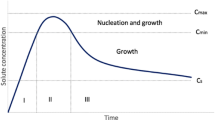Abstract
Extended-release solid dispersions of nonsteroidal antiinflammatory drugs were prepared by using aqueous polymeric dispersions of Eudragit RS30D and Eudragit RL30D as the inert carriers. The effects of different polymer ratios of Eudragit RS30D and Eudragit RL30D, different particle sizes, and different combination of various formulations of solid dispersions on the in vitro release kinetics of drugs from the dosage forms were investigated. A computer curve-fitting process was developed to choose the optimum formulation of the solid dispersion with the desired drug release profile. This process might offer the advantages of efficiency and simplicity in the formulation development of extended-release solid dispersions.
Similar content being viewed by others
REFERENCES
K. Sekiguchi and N. Obi. Studies on absorption of eutectic mixture. I. A comparison of the behavior of eutectic mixture of sulfathiazole and that the ordinary sulfathiazole in man. Chem. Pharm. Bull. 9:866–872 (1961).
W. L. Chiou and S. Riegelman. Pharmaceutical applications of solid dispersion systems. J. Pharm. Sci. 60:1281–1302 (1971).
A. Hasegawa, H. Nakagawa, and I. Sugimoto. Bioavailability and stability of nifedipine enteric coating agent solid dispersion. Chem. Pharm. Bull. 33:388–391 (1985).
M. P. Oth and A. J. Moes. Sustained release solid dispersions of indomethacin with Eudragit RS and RL. Int. J. Pharm. 55:157–164 (1989).
A. Hasegawa, H. Nakagawa, and I. Sugimoto. Solid dispersion obtained from nifedipine and enteric coating agent. I. Dissolution behavior. Yakugaku Zasshi 104:485–489 (1984).
N. A. El-Gindy, A. H. Karara, and M. M. Abd El-khalet. Coprecipitate as a potential technique affecting drug release. Sci. Pharm. 44:315–322 (1976).
N. A. El-Gindy, A. H. Karara, and M. M. Abd El-Khalet. Preparation of prolonged release codeine tablets using the solid dispersion technique. Sci. Pharm. 48:229–235 (1980).
K. S. Murthy, N. A. Enders, M. Mahjour, and M. B. Fawzi. A comparative evaluation of aqueous enteric polymers in capsule coatings. Pharm. Technol. 10(10):36–46 (1986).
S. S. Jambheker, P. J. Breen, and Y. Rojanasakul. Influence of formulation and other factors on the release of chlorpheniramine maleate from polymer coated beads. Drug Dev. Ind. Pharm. 13(15):2789–2810 (1987).
RS/1, Release 4.0, BBN Software Products Corporation. 10 Fawcett Street, Cambridge, MA 02238.
T. Higuchi. Mechanism of sustained-action medication: Theoretical analysis of rate of release of solid drugs dispersed in solid matrices. J. Pharm. Sci. 52:1145–1149 (1963).
Author information
Authors and Affiliations
Rights and permissions
About this article
Cite this article
Ho, C., Hwang, G.CC. Development of Extended-Release Solid Dispersions of Nonsteroidal Antiinflammatory Drugs with Aqueous Polymeric Dispersions: Optimization of Drug Release via a Curve-Fitting Technique. Pharm Res 9, 206–210 (1992). https://doi.org/10.1023/A:1018933306162
Issue Date:
DOI: https://doi.org/10.1023/A:1018933306162




